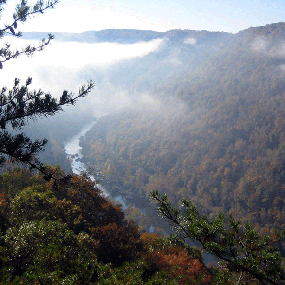
NPS photo, Dave Bieri Established in 1978, New River Gorge National River was redesignated as New River Gorge National Park and Preserve in 2021. The park encompasses over 70,000 acres of land along 53 miles of the New River from Bluestone Dam to Hawk's Nest Lake. A rugged, whitewater river flowing northward through deep and spectacular canyons, the New River is actually among the oldest rivers on Earth. Here in southern West Virginia, the New River has carved and continues to carve the deepest and longest river gorge in the Appalachian Mountains. 
Looking out from the many fantastic viewpoints in the park will also provide a glimpse into the unique cultural history of the New River Gorge area that contributes to the significance of this place. From almost any viewpoint in the park one will see the railroad tracks that opened this rugged and isolated land to the outside world in 1872. From Grandview one will see the rail yards at Quinnimont, where coal was first shipped from the gorge, and the piers of an old bridge which once connected the timber towns of Hamlet and Glade. From Diamond Point hikers will gaze down at the ruins of Kaymoor, an early New River coal mining town. In addition to the coal mines and company towns found throughout the gorge are the old railroad depots, rail yards, rail grades, railroad equipment, and associated towns, like Thurmond, that were developed to support the railroad. Also contributing to the area's rich cultural history are surviving examples of subsistence farms, former community sites, homesteads, and other places in the park where the ancestors of families long associated with the New River lived and worked. Bits of coal along the tracks, rows of old decaying coke ovens, gaping mine openings in the hillsides, old rusted mine cars, and the gravestones of early pioneer families provide tangible reminders of the people who worked and lived here during the late 18th and 19th centuries, supplying the coal and lumber that helped fuel the industrialization of our nation.
Visit our keyboard shortcuts docs for details
Take a journey down the New River and contempate how your experiences on a river can shape you. |
Last updated: January 29, 2021
